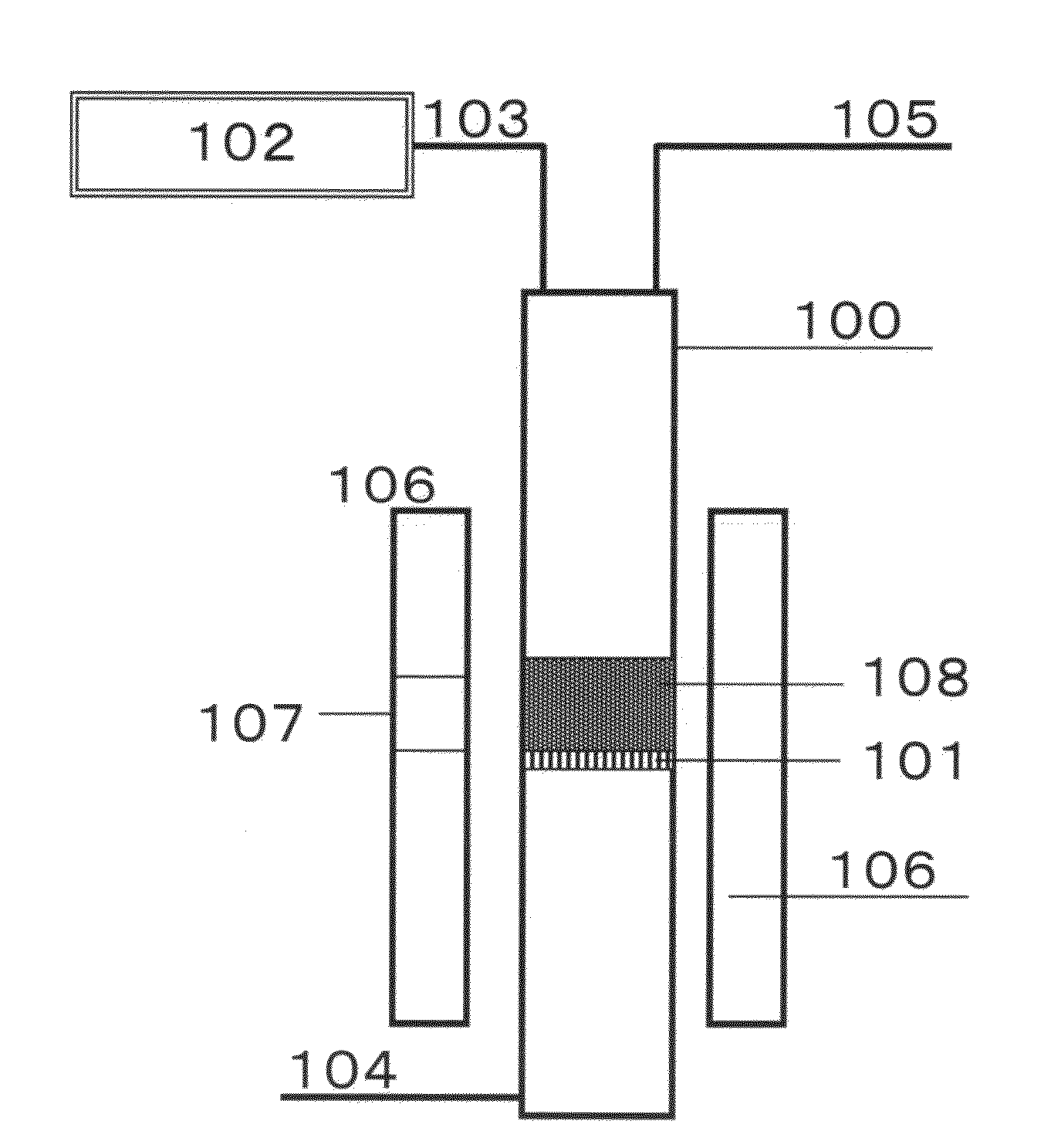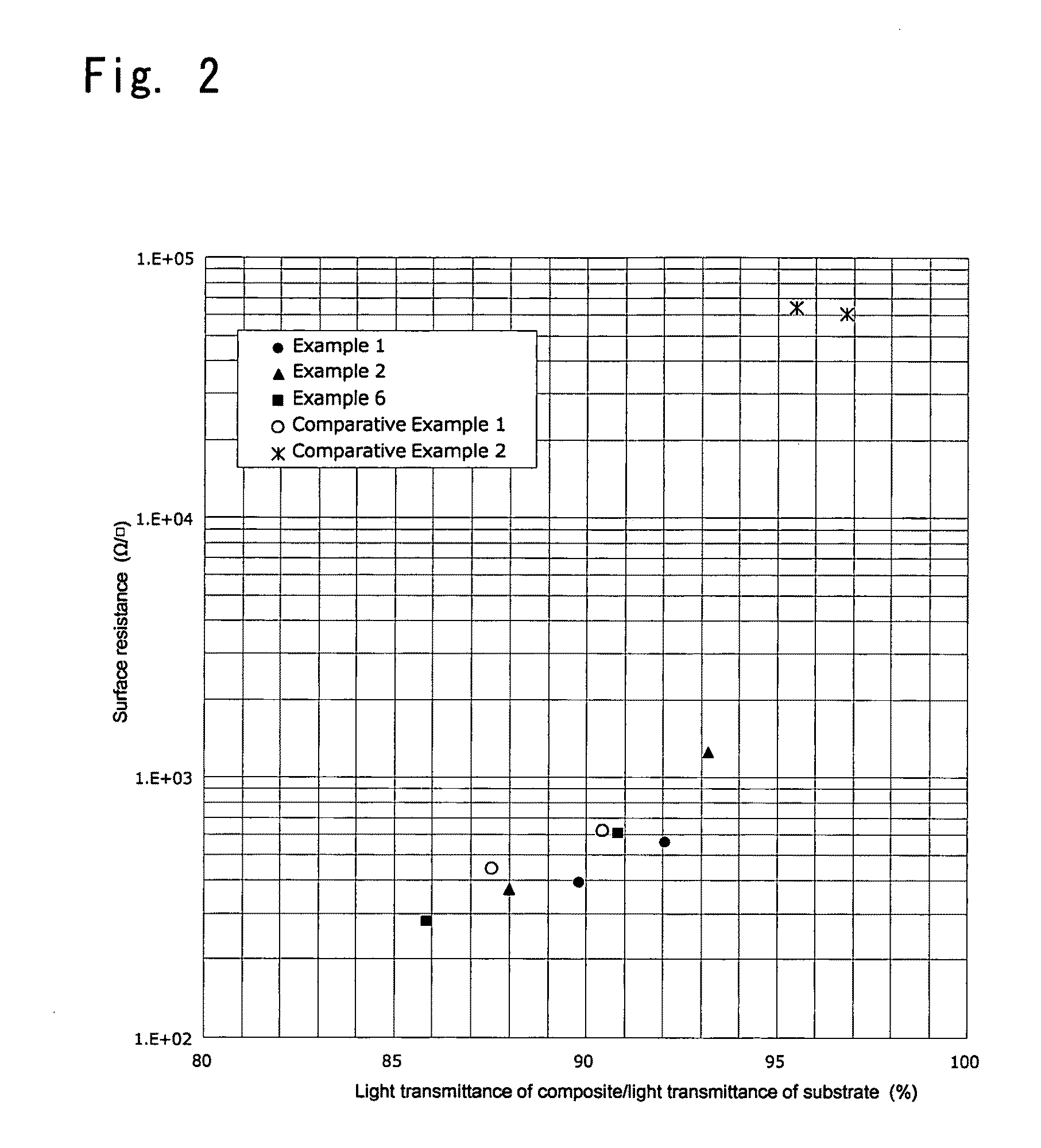Carbon nanotube assembly and process for producing the same
a carbon nanotube and assembly technology, applied in the direction of non-metal conductors, conductors, transportation and packaging, etc., can solve the problems of carbon nanotube damage, low electrical conductivity and heat conductivity of nanotubes, and low degree of graphitization of nanotubes, etc., to achieve excellent light transmittance and surface resistance, excellent electrical conductivity, and easy production
- Summary
- Abstract
- Description
- Claims
- Application Information
AI Technical Summary
Benefits of technology
Problems solved by technology
Method used
Image
Examples
example 1
[0154](Catalyst Preparation) 2.459 g of iron ammonium citrate (green color) (manufactured by Wako Pure Chemical Industries Ltd.) was dissolve in 500 mL of methanol (manufactured by Kanto Chemical Co., Ltd.). To this solution, 100 g of light magnesia (manufactured by Iwatani Corporation, bulk density was 0.125 g / mL.) was added, stirred at room temperature for 60 minutes, while it was stirred from 40° C. to 60° C., methanol was removed by drying under reduced pressure, obtaining a catalyst that a metal salt was supported on light magnesia powder.
[0155](Production of Aggregate of Carbon Nanotubes)
[0156]Carbon nanotubes were synthesized by a fluid bed vertical reactor shown in FIG. 1. A reactor 100 is a cylindrical quartz tube of 32 mm in inner diameter and 1200 mm in length. A quartz sintered plate 101 is equipped in the center part, an inert gas and raw gas supply line 104 in the under part, and a waste gas line 105 and a catalyst input line 103 in the upper part are equipped. Further...
example 2
[0177](Catalyst Preparation)
[0178]A catalyst was prepared in the same manner as Example 1.
[0179](Production of Aggregate of Carbon Nanotubes)
[0180]Production of aggregate of carbon nanotubes was conducted in the same manner as Example 1. However, after heating in concentrated nitric acid, further, burning was conducted in air by an electric furnace at a temperature of 400° C. The aggregate of carbon nanotubes obtained was measured in the same manner as Example 1.
[0181](Measurement of Volume Resistivity)
[0182]The volume resistivity was 5.0×10−3 Ω·cm.
[0183](Evaluation on the Number of Layers of Carbon Nanotube by Transmission Electron Microscope)
[0184]The average of diameter of 100 pieces of carbon nanotubes was 1.8 nm, and the standard deviation of diameter was 0.64 nm. 90 pieces out of 100 pieces were double-walled carbon nanotubes.
[0185](Measurement of weight Loss from 200° C. to 400° C.)
[0186]The weight loss from 200° C. to 400° C. was 5.6%. In this time, the largest peak in the D...
example 3
[0189](Catalyst Preparation)
[0190]A catalyst was prepared in the same manner as Example 1 except that the use amount of iron ammonium citrate (green color) (manufactured by Wako Pure Chemical Industries Ltd.) was 3.279 g, as light magnesia, one manufactured by Wako Pure Chemical Industries Ltd. (bulk density was 0.16 g / mL,) was used.
[0191](Production of Aggregate of Carbon Nanotubes)
[0192]Aggregates of carbon nanotubes were produced in the same manner as Example 1 except that burning temperature in an electric furnace was set to 400° C. The aggregate of carbon nanotubes obtained was measured in the same manner as Example 1.
[0193](Measurement of Volume Resistivity)
[0194]The volume resistivity was 2.7×10−3 Ω·cm.
[0195](Evaluation on the Number of Layers of Carbon Nanotube by Transmission Electron Microscope)
[0196]The average of diameter of 100 pieces of carbon nanotubes was 1.8 nm, and the standard deviation of diameter was 0.79 nm. 85 pieces out of 100 pieces were double-walled carbon...
PUM
 Login to View More
Login to View More Abstract
Description
Claims
Application Information
 Login to View More
Login to View More - R&D
- Intellectual Property
- Life Sciences
- Materials
- Tech Scout
- Unparalleled Data Quality
- Higher Quality Content
- 60% Fewer Hallucinations
Browse by: Latest US Patents, China's latest patents, Technical Efficacy Thesaurus, Application Domain, Technology Topic, Popular Technical Reports.
© 2025 PatSnap. All rights reserved.Legal|Privacy policy|Modern Slavery Act Transparency Statement|Sitemap|About US| Contact US: help@patsnap.com



